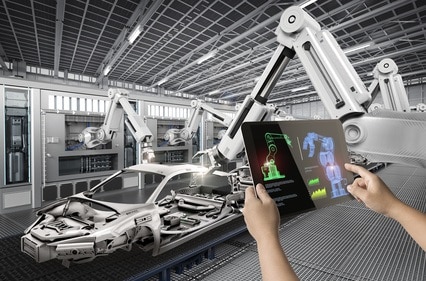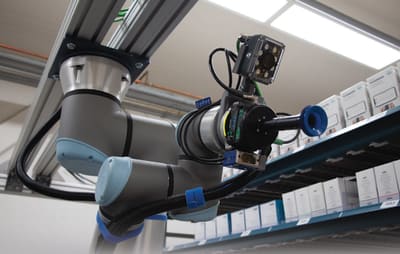How advanced analytics improve results from your robotic vision
Comprehending Robotic Vision: Why It Is Very Important for Modern Automation Processes
Robotic vision stands for a significant development in automation innovation. It permits devices to analyze aesthetic information, boosting their capacity to execute tasks with precision. This capability is transforming markets by improving performance and decreasing human error. The integration of robot vision likewise postures obstacles. Understanding its implications is essential for businesses aiming to remain competitive. What aspects influence its adoption, and how can companies leverage this technology properly?
The Basics of Robotic Vision Technology
Robotic vision technology works as the foundation of automation in numerous sectors, enabling devices to regard and interpret their surroundings. This modern technology integrates sophisticated imaging systems, such as cameras and sensing units, with sophisticated algorithms that refine aesthetic information. By recording images and analyzing them in real-time, robot vision enables makers to recognize objects, examine their positions, and make educated choices based on visual input.Key components of robotic vision consist of picture handling strategies, artificial intelligence designs, and deepness assumption systems, which function jointly to improve a robotic's understanding of its atmosphere. Calibration and environmental adaptability are additionally essential, making sure that systems can function effectively under diverse conditions. This foundational technology not only enhances operational efficiency yet also boosts safety by permitting robots to navigate intricate settings while lessening mistakes and crashes. As sectors remain to evolve, the significance of robust robotic vision modern technology stays paramount in driving development and performance.
Key Applications of Robotic Vision in Industry
The application of robot vision modern technology covers a large range of industries, considerably boosting functional abilities and effectiveness. In manufacturing, robot vision systems allow accurate assessment and quality control, making sure items meet rigorous standards. In the auto market, these systems aid in jobs such as element setting up and defect detection, streamlining manufacturing lines.In logistics, robotic vision plays a vital function in automated product handling, permitting robotics to browse intricate environments and precisely determine products for sorting and packing. The food sector utilizes robotic vision for arranging and packaging, making sure consistency and conformity with health regulations.Additionally, in health care, robot vision aids in surgical treatments and diagnostics, providing enhanced precision and reducing dangers. Overall, the varied applications of robotic vision technology add to raised productivity and advancement across numerous fields, showing its significance in modern commercial procedures.
Benefits of Implementing Robotic Vision Systems
Carrying out robotic vision systems provides numerous advantages that significantly enhance operational performance and precision throughout different markets. These systems allow devices to perceive and translate their environments, leading to improved decision-making procedures. Boosted accuracy in jobs such as quality assurance and arranging decreases human mistake, making sure regular item standards.Moreover, robot vision systems can run continuously, increasing performance while decreasing labor prices. They can carrying out complex jobs at broadband, enabling faster production cycles. The combination of advanced imaging modern technologies helps with real-time data collection, encouraging companies to analyze performance metrics and simplify operations.Additionally, the flexibility of visit this web-site robotic vision systems allows them to be utilized in diverse applications, from vehicle assembly lines to food packaging. By giving dependable and exact automation remedies, these systems aid businesses keep an one-upmanship in a progressively automated industry, highlighting their vital role in contemporary manufacturing environments.
Obstacles and Limitations of Robotic Vision
While robot vision systems use considerable benefits, they additionally face a number of challenges and restrictions that can hinder their performance. One main difficulty is the variability in illumination conditions, which can substantially impact image quality and lead to misconception of aesthetic data. In addition, the complexity of real-world settings, full of dynamic objects and varying textures, poses difficulties in things acknowledgment and tracking.Another restriction is the reliance on premium sensors and advanced algorithms, which can be expensive and require considerable calibration. Additionally, robot vision systems might struggle with deepness perception and three-dimensional understanding, specifically in chaotic settings. fibre testing equipment.Finally, the combination of robotic vision with existing automation systems can be complicated, calling for thorough training and programs. These obstacles underscore the value Read Full Report of continuous r & d to enhance the capabilities and dependability of robot vision innovations in different applications
The Future of Robotic Vision in Automation
The future of robotic vision in automation assures substantial advancements in improved item acknowledgment and enhanced navigating systems. As technology evolves, these technologies will certainly make it possible for robotics to connect much more successfully with their settings and perform complex jobs with better precision. This development is anticipated to redefine functional abilities across numerous markets.
Enhanced Object Acknowledgment


Boosted object acknowledgment stands at the center of improvements in robot vision, transforming how automation systems view and connect with their environments. This innovation makes it possible for robotics to recognize and classify a vast array of items with exceptional accuracy, assisting in a lot more efficient procedures throughout various sectors. Utilizing deep knowing algorithms and advanced imaging strategies, systems can acknowledge things in vibrant settings, adapting to adjustments in illumination, angles, and occlusions. Therefore, improved object recognition not only enhances processes such as sorting, choosing, and top quality control but also go minimizes errors and increases productivity. The continuous growth in this area promises to even more incorporate robotics into daily jobs, considerably boosting functional efficiency and paving the method for smarter automation remedies.
Better Navigating Solutions
Advancements in navigation systems are positioned to change robotic vision in automation, enabling robots to go across complex settings with unprecedented precision. By integrating sophisticated sensors, expert system, and equipment discovering formulas, these systems promote real-time mapping and localization. This allows robots to adjust to vibrant environments, staying clear of challenges and enhancing paths efficiently. Enhanced navigation capabilities empower robots to carry out tasks in different settings, from warehouses to health care centers, improving productivity and security. Furthermore, the constant development of these modern technologies guarantees to lower functional prices by decreasing errors and downtime. As the need for automation increases, boosted navigating systems will certainly play a pivotal role fit the future of robot vision, making certain seamless integration into everyday procedures.
Integrating Robotic Vision With Other Technologies
Incorporating robot vision with other innovations significantly enhances automation capacities across numerous markets. By incorporating advanced imaging systems with expert system, artificial intelligence, and Net of Points (IoT) connectivity, organizations can achieve unprecedented effectiveness and precision in their procedures. Robotic vision can be used in combination with equipment discovering algorithms to boost item recognition and decision-making processes, enabling robotics to adjust to dynamic environments.Additionally, when incorporated with IoT devices, robot vision systems can assist in real-time data analysis and responses loopholes, optimizing operations and reducing downtime. This harmony permits precise high quality control and predictive maintenance, eventually lessening operational expenses. Integration with collective robotics (cobots) boosts human-robot interaction, making automation much safer and a lot more effective in environments where human oversight is necessary. The merging of robotic vision with corresponding innovations is essential for driving innovation and performance in modern automation procedures.
Often Asked Concerns
Just How Does Robotic Vision Differ From Human Vision?

What Sorts of Cameras Are Made Use Of in Robotic Vision?
Different kinds of cameras are utilized in robotic vision, including CCD, CMOS, and deepness cams. optical measurement system. These cameras enable robotics to perceive their setting, promoting jobs such as things acknowledgment, navigating, and high quality evaluation in automated systems
Can Robotic Vision Systems Gain From Experience?
Robotic vision systems can certainly gain from experience. Through sophisticated algorithms and artificial intelligence strategies, they adapt and enhance their aesthetic recognition capabilities, improving their performance in numerous tasks over time as they refine brand-new information.
How Do Lighting Issues Affect Robotic Vision Efficiency?
Lights conditions substantially affect robotic vision efficiency by influencing photo comparison, shade accuracy, and item detection abilities. Inadequate or excessive light can result in false impression of visual information, impacting the general performance of robotic systems.
Are There Safety And Security Concerns With Using Robotic Vision?
Safety worry about robot vision consist of potential misconceptions of environments, leading to mishaps. Insufficient sensor calibration or environmental modifications can intensify these dangers, demanding extensive screening and adherence to safety and security criteria for effective execution.